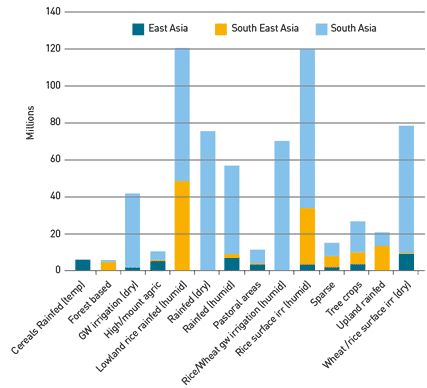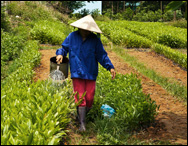New Report : Water and the Rural Poor: Asia
Interventions for improving livelihoods in Asia
 Despite fast growing economies, rural poverty in Asia continues to be a major concern, whose challenges are further made complex by societal transformations and increasing climate variability.
This new FAO report demonstrates the potential for water interventions in support of poverty reduction by identifying hotspots of poverty and water constraints in Asia. The report analyses the characteristics of some 14 major livelihood systems in three sub-regions and assessessing for each one of them, the physical potential, the demand, and the priorities for water interventions.
The range of options identified aims to address rural poverty through four main areas of intervention:
Despite fast growing economies, rural poverty in Asia continues to be a major concern, whose challenges are further made complex by societal transformations and increasing climate variability.
This new FAO report demonstrates the potential for water interventions in support of poverty reduction by identifying hotspots of poverty and water constraints in Asia. The report analyses the characteristics of some 14 major livelihood systems in three sub-regions and assessessing for each one of them, the physical potential, the demand, and the priorities for water interventions.
The range of options identified aims to address rural poverty through four main areas of intervention:
- increasing availability of, andaccess to, water;
- increasing water productivity and value added of water;
- addressing vulnerability to floods and droughts, and rainfall variability in general; and
- promoting multiple-use water services (MUS).

The relative importance of each one of these areas of intervention varies among livelihood systems, the level of poverty, the nature of water constraints and the livelihood context in general. Rural poverty across livelihood systems
 The study also provides a typology of Asian farmers by looking at landholdings, nature of farming (from subsistence to commercial), and the role of non-farm sectors in rural livelihoods. This latter is of particular relevance in many areas of Asia where the share of non-farm economic sector’s contribution is steadily rising in the rural economy, bringing new hopes and opportunities, but also risks and challenges.
Improved and better integrated water management remains central to rural livelihoods because of its strong links to society, agricultural growth, environmental management and climate change adaptation, even more so in a continent in transition such as Asia.
The study also provides a typology of Asian farmers by looking at landholdings, nature of farming (from subsistence to commercial), and the role of non-farm sectors in rural livelihoods. This latter is of particular relevance in many areas of Asia where the share of non-farm economic sector’s contribution is steadily rising in the rural economy, bringing new hopes and opportunities, but also risks and challenges.
Improved and better integrated water management remains central to rural livelihoods because of its strong links to society, agricultural growth, environmental management and climate change adaptation, even more so in a continent in transition such as Asia.
Download the report >>
